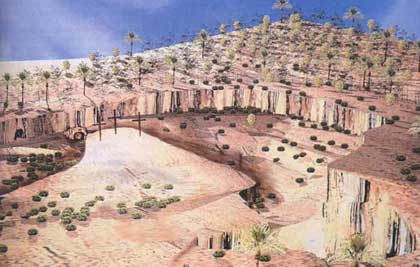6. Patriarchate of Jerusalem  6.2 Holy Church of Resurrection
6.2 Holy Church of Resurrection

Speakage: Riva Lava :: Sound engineer: Nikos Myrtou
6.2 Holy Church of Resurrection
TOPOGRAPHICAL AND ARCHITECTURAL DOCUMENTATION OF THE HOLY SEPULCHRE, JERUSALEM.
The Church of the Anastassis (Resurrection) or of Sepulchre, as it is mostly known to western visitors, lies majestically in the heart of the Old City Jerusalem and has a very long history spanning over twenty centuries. The first church in this site was erected by Saint Helen, the mother of Emperor Constantine the Great, when she discovered the Holy Cross at the beginning of the fourth century A.D. Since then a lot of constructions, modifications, additions, renovations and alterations took place, the major one being the one imposed by the crusaders in the 12th cent. A.D. when they conquered the Holy Land. Today the Church complex is a living monument and it is visited every year by thousands of pilgrims. All different Christian communities are represented and active within its walls. Greek Orthodox, Roman Catholic Franciscan, Armenian and Coptic priests and monks are more or less coexisting in harmony, worshipping the same God. The monument is divided into sections, each one “belonging” to a community. There are, of course, sections of it common to everybody. This unique state of ownerships is respected by all communities and is hardly noticed by the visitors. It constitutes the Status Quo of the Church of the Holy Sepulchre, which has its origins in historical tradition. During all the years of its existence, very few efforts have been made to geometrically document the monument in an objective and thoroughly scientific way. Perhaps the most complete, although not fully, geometric documentation was the one carried out by V.C Corbo (Corbo, 1981), a Franciscan monk who devoted a long period of his life to this goal. Without modern means Corbo managed to produce drawings of good quality, but of debatable reliability. Another serious attempt was the one carried out by M. Cooper and his team (Biddle et al. 1992 and Cooper et al. 1992). However, their effort was concentrated mainly on the Edicule, i.e. the construction within the Church of the Holy Sepulchre covering the Tomb of Christ. Hence the need for a thorough geometric documentation or survey was more than apparent. The National Technical University of Athens (N.T.U.A.) joined forces to confront this task, having at the same time the full support of the Greek Orthodox Patriarchate. The fieldwork was extended to seven consecutive monthly campaigns from 1993 to 1999. Every year a team of surveyors, architects, photographers and archaeologists worked together for the collection of the field data.
The field work was executed for one month each year for seven consecutive years. The data collected during those 210 days comprised of:
- Establishment and measurement of 150 theodolite stations.
- Determination of 23000 geodetically measured points, including control points, section points, detail points etc.
- 1500 metric and 500 non-metric images for photogrammetric processing.
- 2000 photographs taken for documentation purposes.
All collected data were suitably archived on site. Especially for the measured points a special codification was devised, in order to enable the own developed calculation software to distinguish the various kinds of points. Each point was codified with a six digit number, the fields of which had a special meaning: A B C D E F
A: Kind of point, 1 theodolite station
2 premarked control point
3 detail control point
4 section point
BC: code number of crossection
DEF: serial number of point
The basic section lines for each cross section were plotted within the AutoCAD environment. Initially, version 10 of the software was used, while for the last campaign, i.e. seven years later version 2000!! For the correct projection of the points a 3D rotation was considered necessary. For this purpose a special software was developed in order to perform this rotation. It was also established that most photogrammetric software refuses to perform the adjustment of a stereopair if the reference system of the control points does not simulate the situation of the aerial photography. This means that the reference system should have the Z axis pointing towards the camera. All photogrammetric stereopairs were oriented and plotted either on a Leica DVP digital stereoplotter, or an Adam MPS-2 analytical stereoplotter. The three dimensional photogrammetric outputs were later processed by the team of architects, in order to produce the final drawings.
An interesting project was the compilation of the drawing of the roof tops. As aerial photography over the Old City Jerusalem was prohibited, the plan was compiled by suitably adjusting photogrammetric measurements from several 35mm colour slides taken with an amateur camera and a zoom lens with unknown geometry. A total of 35 drawings were produced. Included are the four plots of the plan drawing. All these plans cover an area of 40.000 square metres, approximately at the scale of 1:50.
This unique project can never end. The complexity of a monument such as the Church of the Holy Sepulchre, does not present an easy task, when its documentation is concerned. Moreover the fact that it is a living monument presents even more difficulties. All religious communities, active within its walls and the endless crowds of pilgrims who visit the Church every day all year round, present even more obstacles, which can never be overcome or set aside. One should work with respect to the place and the people active in it. However this project has been an excellent example of cooperation. On the one hand, there is interdisciplinary co-operation. Surveyors, Architects, Photographers, Archaeologists and Photogrammetrists worked harmoniously for a really long time under adverse conditions to complete the difficult task. On the other hand, there is interreligious co-operation. Greek Orthodox, Roman Catholics, Armenians, Syrian Copts and Ethiopians agreed and allowed our group to momentarily disturb their peace and perform our measurements.





















